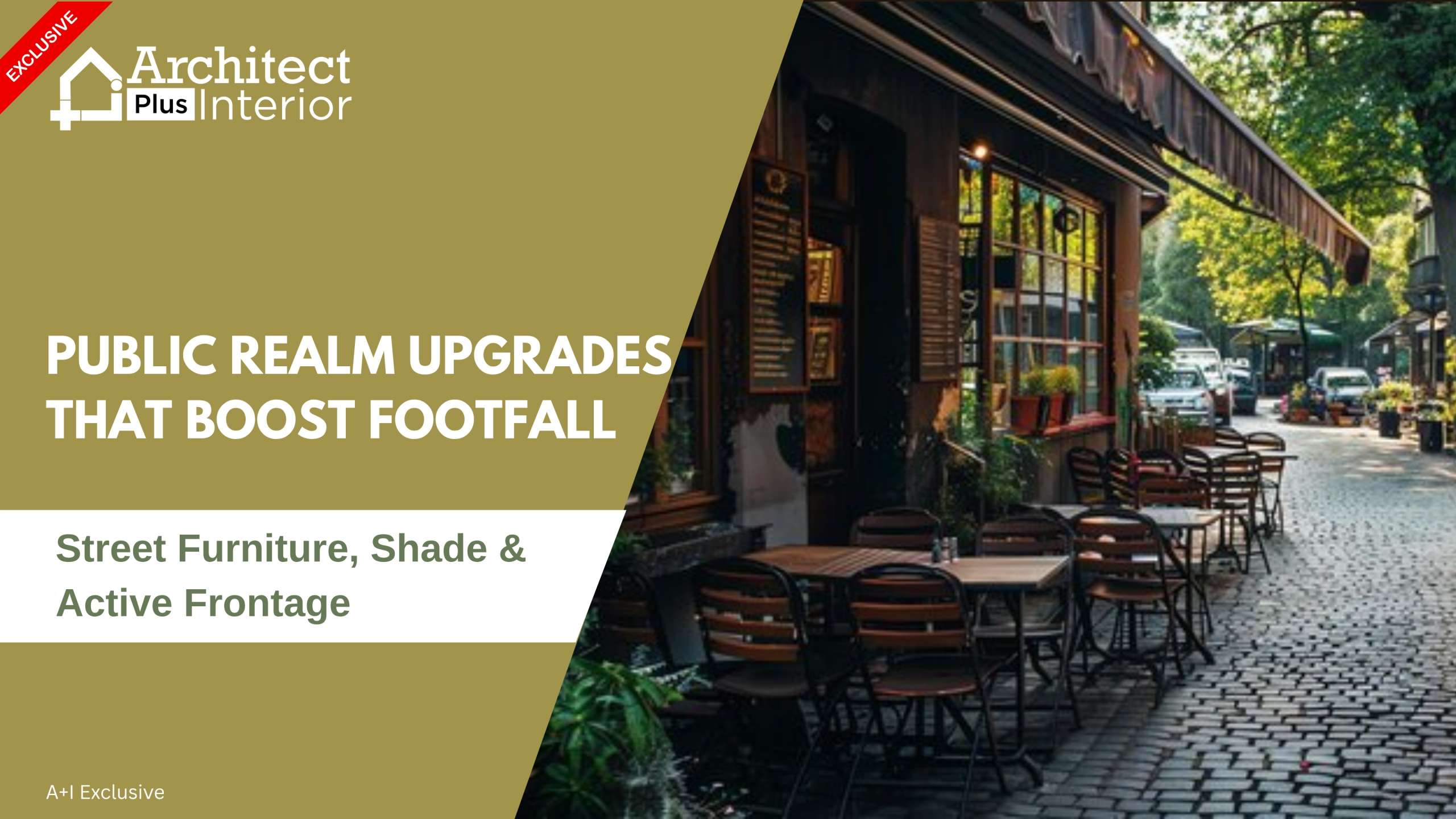Upgrading the public realm is essential for creating vibrant, high-footfall urban spaces. In 2025, cities worldwide are reimagining streetscapes to welcome residents and visitors alike—using well-chosen interventions that invite people to linger, interact, and return.
1. Street Furniture: Comfort Meets Functionality
Modern benches, tables, bike racks, bins, bollards, and signage serve much more than utilitarian roles. Strategically placed and thoughtfully designed street furniture transforms sidewalks into social hubs, offers rest points for all ages, and guides pedestrian movement—making streets more inviting and accessible. Durable, eco-friendly materials and user-friendly forms support inclusivity, comfort, and safety.
Explore space-enhancing design:
- Industrial Chic: This Sculptural Building Marries Art And Wine
- Discover This Shanghai Office Enlivened By The Color Red
2. Shade & Shelter: Climate-Responsive Urbanism
As cities get hotter, shade structures and canopies are more important than ever. Trees, retractable awnings, and covered seating help moderate temperatures, encourage people to spend time outdoors, and support walkability even in summer months. Innovative shade can be beautiful: sculptural pavilions, green roofs, or seasonal installations provide visual interest along with weather protection.
Get inspired by creative projects:
- Modular and Prefabricated Buildings: Fast-Tracking Construction’s Future
- Semicircular Skylights Cast Sunbeams Across Takeshi Hosaka’s Concrete Residence in Tokyo
3. Active Frontage: Engaging the Street
High-impact public spaces rely on active frontages—shops, cafes, and ground-floor windows that create transparency, permeability, and constant street-level engagement. Facades with large windows, open entries, outdoor seating, and dynamic displays bring activity onto the sidewalk, boosting foot traffic and energizing the entire district. Interactive designs—like digital screens and public art—build a sense of place and strengthen local identity.
See more engaging architecture:
- Shake It Up At This Bold Apartment Complex In The Bronx
- Kengo Kuma Designs A Tokyo Café With A Dynamic Facade
Urban Design Best Practices for Footfall
- Create uncluttered, cohesive streetscapes with unified furniture and clear pathways.
- Combine green infrastructure (trees, planters) with flexible seating and interactive spaces.
- Prioritize transparent, welcoming shopfronts and active ground-floor uses.
- Use public lighting and safety-conscious design to extend usable hours.
- Engage local artists for temporary installations and events.
Stay Updated and Explore More Projects:
For the latest trends on boosting footfall, check out Trending Posts and Projects Showcase.
Through smart improvements in street furniture, shade, and frontage design, cities nurture public life and drive sustained economic and social vitality.Public Realm Upgrades That Boost Footfall: Street Furniture, Shade, and Active Frontage
Thoughtful enhancements to public spaces are proven catalysts for vibrant urban life, drawing visitors and locals alike while supporting commerce and community. In 2025, city designers are leveraging three essential upgrades—street furniture, shade, and active frontages—to create pedestrian-friendly destinations.
Street Furniture: Comfort and Identity
Modern benches, bike racks, bins, and planters are more than amenities—they provide rest, signal identity, and guide movement. Strategically placed, durable street furniture invites people to dwell, meet, and enjoy the area.
See creative approaches to urban furniture in:
- Industrial Chic: This Sculptural Building Marries Art And Wine
- Discover This Shanghai Office Enlivened By The Color Red
Shade: Climate-Responsive Design
In warmer cities, shade boosts comfort and time spent outdoors. Trees, canopies, pergolas, and innovative climate-responsive structures create refuge from the sun and rain—turning open spaces into highly usable environments year-round.
Explore inspiring shade solutions in:
- Modular and Prefabricated Buildings: Fast-Tracking Construction’s Future
- Semicircular Skylights Cast Sunbeams Across Takeshi Hosaka’s Concrete Residence in Tokyo
Active Frontage: Energy That Spills onto the Street
Engaging shopfronts, cafes with outdoor seating, and transparent facades activate sidewalks and streets, energizing public spaces and encouraging footfall. Open windows, visible displays, and permeability are keys to a lively ground-floor scene.
Discover dynamic public frontages in:
- Shake It Up At This Bold Apartment Complex In The Bronx
- Kengo Kuma Designs A Tokyo Café With A Dynamic Facade
Best Practices
- Use unified furniture and unobstructed pathways for accessibility.
- Combine natural shade and shelter with inviting seating.
- Foster interactive ground-floor uses for retail, art, or food.
- Integrate lighting and greenery for atmosphere and safety.
See More Projects and Urban Trends:
Visit Trending Posts and the Projects Showcase for examples and case studies.
Urban spaces thrive on comfort, engagement, and identity. By upgrading street furniture, shade, and active frontage, cities create places where people love to linger, socialize, and shop—boosting footfall and local vitality.



